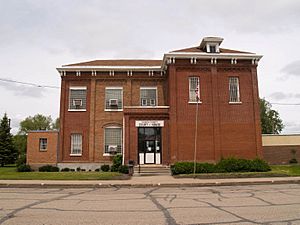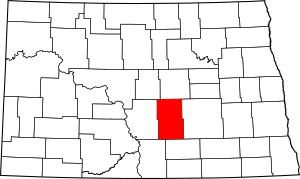Kidder County, North Dakota facts for kids
Quick facts for kids
Kidder County
|
|
|---|---|

The Kidder County Courthouse in Steele
|
|

Location within the U.S. state of North Dakota
|
|
 North Dakota's location within the U.S. |
|
| Country | |
| State | |
| Founded | January 4, 1873 (created) March 22, 1881 (organized) |
| Named for | Jefferson Kidder |
| Seat | Steele |
| Largest city | Steele |
| Area | |
| • Total | 1,433 sq mi (3,710 km2) |
| • Land | 1,351 sq mi (3,500 km2) |
| • Water | 82 sq mi (210 km2) 5.7% |
| Population
(2020)
|
|
| • Total | 2,394 |
| • Estimate
(2022)
|
2,393 |
| • Density | 1.6706/sq mi (0.6450/km2) |
| Time zone | UTC−6 (Central) |
| • Summer (DST) | UTC−5 (CDT) |
| Congressional district | At-large |
Kidder County is a county located in the U.S. state of North Dakota. As of the 2020 census, the population was 2,394. Its county seat is Steele.
Contents
History
The Dakota Territory legislature created the county on January 4, 1873, with areas partitioned from Buffalo County. The county government was not organized at that time, nor was the area attached to another county for administrative or judicial purposes. It was named for Jefferson Parrish Kidder, a delegate to the United States Congress from Dakota Territory (1875–1879) and associate justice of the territorial supreme court (1865–1875, 1879–1883). The county government was effected on March 22, 1881.
The county boundaries were altered on 1879 with territory partitioned to Burleigh, and in 1885 with territory partitioned from Burleigh County. Its boundaries have remained unchanged since 1885.
Geography
The terrain of Kidder County consists of hills dotted with lakes and ponds, largely devoted to agriculture. The terrain slopes to the east and south; its highest point is a hill near its northwestern corner, at 2,064 ft (629 m) ASL. The county has a total area of 1,433 square miles (3,710 km2), of which 1,351 square miles (3,500 km2) is land and 82 square miles (210 km2) (5.7%) is water.
Major highways
 I-94
I-94 ND 3
ND 3 ND 36
ND 36
Lakes
Source:
- Alkali Lake
- Alkaline Lake
- Ashley Lake
- Big Muddy Lake
- Bird Lake
- Buffalo Lake
- Cherry Lake
- Dead Buffalo Lake
- Deer Lake
- Fresh Lake
- Geneva Lake
- Harker Lake
- Horsehead Lake
- Kunkel Lake
- Lake Etta
- Lake George
- Lake Helen
- Lake Henry
- Lake Isabel
- Long Alkaline Lake
- Long Lake (partial)
- McPhall Slough
- Mud Lake
- Pursian Lake
- Round Lake
- Salt Alkaline Lake
- Sibley Lake
- Swan Lake
- Upper Harker Lake
- Willow Lake
- Woodhouse Lake
Adjacent counties
- Wells County - north
- Stutsman County - east
- Logan County - south
- Emmons County - southwest
- Burleigh County - west
- Sheridan County -northwest
Protected areas
Source:
- Alkaline Lake State Wildlife Management Area
- Dawson State Game Management Area
- Hutchinson Lake National Wildlife Refuge
- Lake George National Wildlife Refuge
- Lake Williams State Game Management Area
- Long Lake National Wildlife Refuge (part)
- Slade National Wildlife Refuge
- Streeter Memorial State Park
Demographics
| Historical population | |||
|---|---|---|---|
| Census | Pop. | %± | |
| 1880 | 89 | — | |
| 1890 | 1,211 | 1,260.7% | |
| 1900 | 1,754 | 44.8% | |
| 1910 | 5,962 | 239.9% | |
| 1920 | 7,798 | 30.8% | |
| 1930 | 8,031 | 3.0% | |
| 1940 | 6,692 | −16.7% | |
| 1950 | 6,168 | −7.8% | |
| 1960 | 5,386 | −12.7% | |
| 1970 | 4,362 | −19.0% | |
| 1980 | 3,833 | −12.1% | |
| 1990 | 3,332 | −13.1% | |
| 2000 | 2,753 | −17.4% | |
| 2010 | 2,435 | −11.6% | |
| 2020 | 2,394 | −1.7% | |
| 2022 (est.) | 2,393 | −1.7% | |
| U.S. Decennial Census 1790-1960 1900-1990 1990-2000 2010-2020 |
|||
2020 census
As of the census of 2020, there were 2,394 people.
2010 census
As of the census of 2010, there were 2,435 people, 1,059 households, and 722 families in the county. The population density was 1.8 inhabitants per square mile (0.69/km2). There were 1,674 housing units at an average density of 1.2 units per square mile (0.46/km2). The racial makeup of the county was 96.3% white, 0.9% Asian, 0.2% American Indian, 0.2% black or African American, 1.9% from other races, and 0.4% from two or more races. Those of Hispanic or Latino origin made up 2.9% of the population. In terms of ancestry, 65.8% were German, 21.8% were Norwegian, 8.2% were Russian, 6.0% were English, and 1.7% were American.
Of the 1,059 households, 24.3% had children under the age of 18 living with them, 58.3% were married couples living together, 5.0% had a female householder with no husband present, 31.8% were non-families, and 28.1% of all households were made up of individuals. The average household size was 2.30 and the average family size was 2.77. The median age was 47.2 years.
The median income for a household in the county was $34,250 and the median income for a family was $47,981. Males had a median income of $35,380 versus $24,330 for females. The per capita income for the county was $23,502. About 15.1% of families and 17.9% of the population were below the poverty line, including 29.1% of those under age 18 and 23.1% of those age 65 or over.
Population by decade

Communities
Cities
Unincorporated communities
Townships
- Allen
- Atwood
- Baker
- Buckeye
- Bunker
- Chestina
- Clear Lake
- Crown Hill
- Crystal Springs
- Excelsior
- Frettim
- Graf
- Haynes
- Lake Williams
- North & South Manning
- North & South Merkel
- Northwest
- Peace
- Petersville
- Pettibone
- Pleasant Hill
- Quinby
- Rexine
- Robinson
- Sibley
- Stewart
- Tanner
- Tappen
- Tuttle
- Valley
- Vernon
- Wallace
- Weiser
- Westford
- Williams
- Woodlawn
Unorganized territories
- Kickapoo
- Liberty
See also
 In Spanish: Condado de Kidder (Dakota del Norte) para niños
In Spanish: Condado de Kidder (Dakota del Norte) para niños


